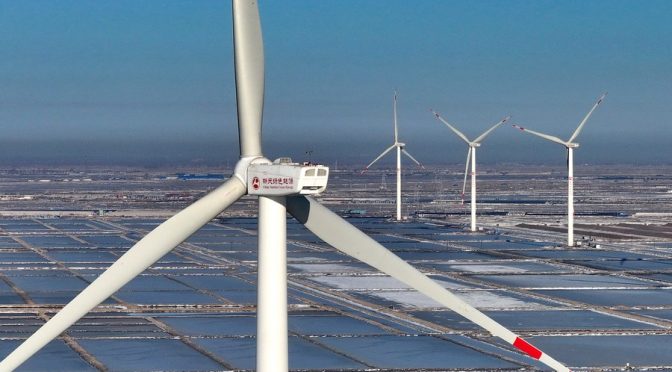According to a simulation model, almost 6 terawatts of renewable energy will be needed for the country to reach that goal in 2060.
80 percent of solar PV and 55 percent of wind power will need to be installed within a 100-kilometer radius of major load centers to meet demand.
China will need nearly 6 terawatts of solar and wind power to achieve its goal of becoming carbon neutral by 2060, according to a new model simulation.
That would be double China’s total energy generation capacity now, and more than five times the current capacity in the United States.
The study was a collaboration between scientists at the University of California San Diego and Tsinghua University in Beijing.
Their simulation found that if China is to meet its lofty carbon neutrality goal, it will need to have 2TW of wind power capacity and 3.9TW of solar installed – or around 10 times more than the country had in 2022.
“The required deployment rates in mid-century are close to what has been reported for 2023, though there will still be challenges to sustain that over time,” said Michael Davidson, senior author of the study and a professor at UC San Diego.
To meet demand in China’s major energy load centres, 80 per cent of the solar power and 55 per cent of wind power will have to be installed within 100km (62 miles) of those centres, the team wrote in a paper published in the peer-reviewed Proceedings of the National Academy of Sciences on Tuesday.
They said deploying that much solar capacity could use up more than 80 per cent of suitable land in eastern provinces like Anhui and Zhejiang, where electricity demand is highest.
“We know China has a very ambitious pathway to achieve carbon neutrality. We wanted to find out exactly what that entails,” Davidson told US San Diego’s news site.
The team ran a “highly spatially resolved model” which took into account China’s current grid integration, land use, energy storage and government policies. They said it could be adapted to assess other countries.
The model simulated China’s power grid in 2060 with “unprecedented” resolution, the UC San Diego report said. Individual land plots in the model were as small as 20 sq km.
China’s energy sector transformation is “at the heart” of worldwide efforts to achieve net-zero emissions by the middle of the century to limit global warming to 2 degrees Celsius, according to the scientists.
The country has emerged as a global leader in renewable energy expansion in recent years, but it is also the world’s largest energy consumer and greenhouse gas emitter.
In 2020, President Xi Jinping announced that China would aim to peak emissions by 2030 and achieve net-zero carbon neutrality by 2060, in line with global climate goals.
The researchers said that to meet this target, China will need “a suite of zero- and negative-emissions generating technologies as well as complementary storage and transmission infrastructure”.
Electricity is central to the green transition since decarbonisation in other sectors such as transport also rely on it, and it can be used to offset other hard-to-abate sectors, according to the paper.
It said new solar installations would be needed in regions where electricity demand is high, and they would take up a large proportion of land suitable for this purpose.
The researchers noted that land-use competition would be a significant challenge and “increasingly contentious” since land deemed suitable for solar was also used to meet agricultural needs.
Wind power could be installed more readily throughout the country, both in existing wind centres in the northern regions as well as new sites in eastern and central provinces. The team noted both options were cost-effective.
They said although the northwestern and northeastern regions had more wind and solar resources, the challenges of transporting energy and a lack of demand centres in those areas meant less capacity should be installed there.
Beyond the expansion of solar and wind power, an “unprecedented” 1,000 gigawatts of energy storage will also be needed to provide reserve energy during peak demand, mostly for solar.
According to the model, interprovincial ultra-high-voltage energy transmission lines will need to be double the current size. That will involve expanding the existing lines as well as building new ones.
The researchers said the model was created with the expectation that China would continue to “exploit” its existing hydropower resources, and that just over 200GW of coastal nuclear power would be added.
Coal is also not completely off the table. For the simulation, it retained a role in the north of the country for district heating networks, many of which are new.
The scientists concluded that retiring them would be “unnecessary”. They said all coal plants should instead be retrofitted with carbon capture and storage, which the government has already begun to do.
“Effective planning and policy formulation are necessary to achieve China’s climate goals,” including market reforms and extensive planning, according to the paper.
The scientists said the model could “reveal details of large-scale carbon-negative power systems from a coupled land and grid perspective”, but further research could be done on non-electricity sectors.


